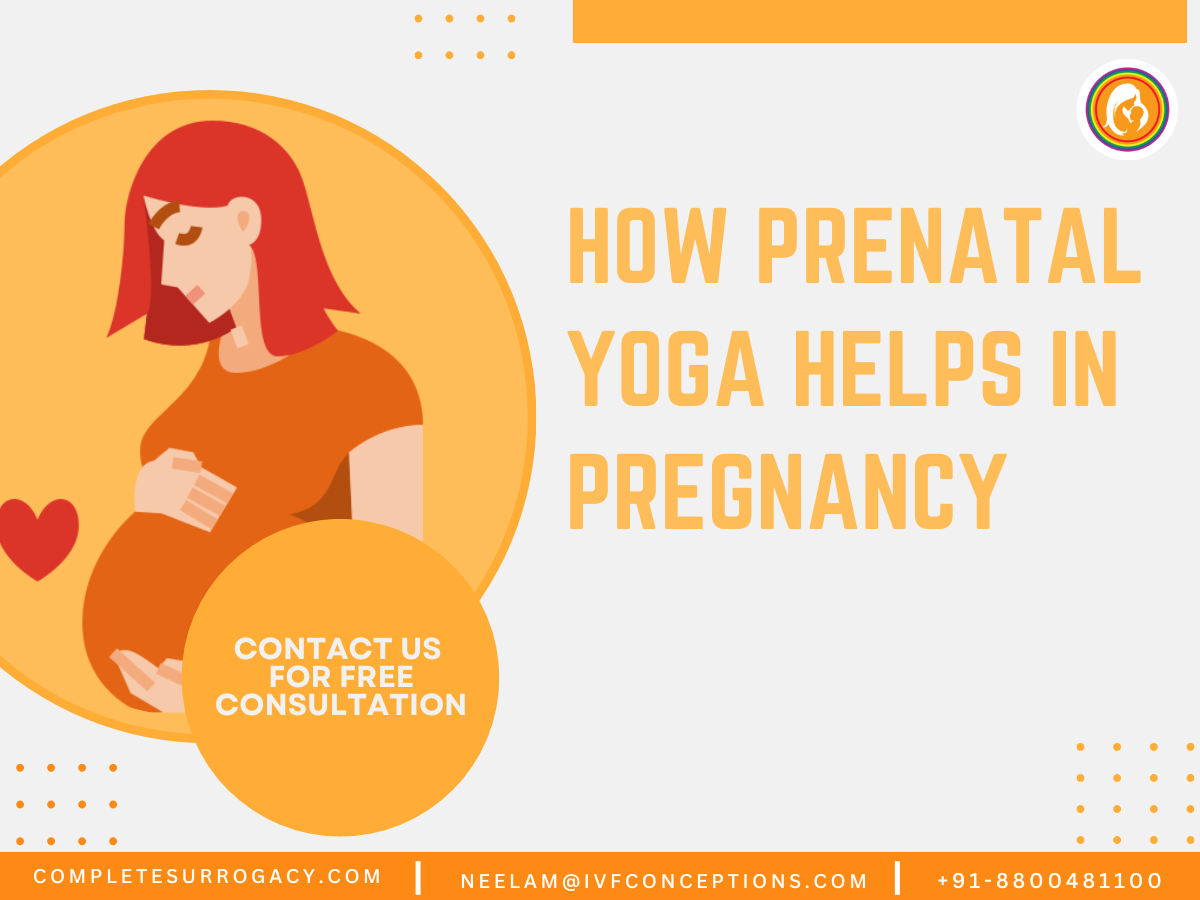How Prenatal Yoga Helps in Pregnancy- Your Comprehensive Guide

Prenatal yoga is a specialized form of yoga that supports women throughout their pregnancy journey. According to the American Congress of Obstetricians and Gynecologists (ACOG), staying active during pregnancy can have numerous benefits, including increased energy, improved mood, and better sleep.
This gentle yet effective exercise combines physical postures, breathing techniques, and meditation to address the unique needs of pregnant women. By practicing prenatal yoga, women can alleviate common pregnancy discomforts, prepare their body and mind for labor and delivery, and create a foundation for a healthier pregnancy experience.
Key Takeaways- How Prenatal Yoga Helps in Pregnancy
- Prenatal yoga is a low-impact exercise that can be safely initiated during pregnancy.
- It combines physical postures, breathing techniques, and meditation to support maternal wellness.
- Practicing prenatal yoga can help alleviate common pregnancy discomforts.
- It prepares the body and mind for labor and delivery.
- Prenatal yoga promotes a healthier and more comfortable pregnancy experience.
📞 Get in Touch for a Free Surrogacy Consultation
📱 +91-8800481100 (WhatsApp | LINE | Viber)
📧 neelam@ivfconceptions.com
Additional guide:
Can Acupuncture Treat Infertility? A Comprehensive Guide
Exploring Current Infertility Options for Intended Parents
Moving From Infertility Treatment To Surrogacy Process
What is Infertility Counseling for Surrogacy?
What Is Prenatal Yoga?
Prenatal yoga offers a nurturing environment for pregnant women to connect with their bodies and prepare for childbirth. This specialized form of yoga is designed to support women throughout their pregnancy journey, focusing on gentle stretches, breathing techniques, and relaxation methods.
As an exercise tailored for pregnancy, prenatal yoga helps women stay physically active while addressing the unique challenges of this period. It’s not just about physical postures; it’s also about creating a mental and emotional connection with the growing baby.
Differences from Regular Yoga
Prenatal yoga differs significantly from regular yoga in its approach and focus. While traditional yoga encompasses a wide range of styles and intensities, prenatal yoga is specifically designed to be safe and beneficial during pregnancy.
It avoids poses that could be harmful, such as deep twists, intense backbends, or poses that involve lying flat on the back after the first trimester.
The practice is tailored to accommodate the physical changes women experience during pregnancy, including postural adjustments and relaxation techniques to manage discomfort and stress.
| Aspect | Prenatal Yoga | Regular Yoga |
|---|---|---|
| Focus | Safe for pregnancy, gentle stretches | Various styles, intensities, and focuses |
| Postures | Avoids harmful poses, accommodates pregnancy changes | Includes a wide range of postures |
| Benefits | Prepares body for childbirth, reduces pregnancy discomfort | Improves flexibility, strength, and mental well-being |
Who Can Practice Prenatal Yoga?
Prenatal yoga is accessible to women at all stages of pregnancy, though it’s recommended that they get medical clearance before starting, especially for those with high-risk pregnancies. The practice is adaptable to different experience levels, so both experienced yogis and complete beginners can benefit from it.
“Prenatal yoga is for every woman, regardless of her yoga experience. It’s about creating a safe space for expectant mothers to nurture their bodies and minds.”
- Women with no prior yoga experience may find prenatal yoga an excellent introduction.
- Those with existing yoga practices will need to modify their routine as pregnancy progresses.
The Benefits of Prenatal Yoga During Pregnancy
Prenatal yoga is a holistic approach to supporting women’s health throughout their pregnancy journey. It encompasses a range of practices that cater to the physical, mental, and emotional changes experienced during pregnancy.
By incorporating prenatal yoga, expectant mothers can navigate their pregnancy with greater ease and comfort.
Physical Benefits
The physical benefits of prenatal yoga are multifaceted, contributing to a healthier and more comfortable pregnancy. Two significant advantages include improved strength and flexibility, as well as reduced pregnancy discomforts.
Improved Strength and Flexibility
Prenatal yoga helps in maintaining and improving flexibility, which is crucial as the body undergoes significant changes. The practice involves gentle stretches and postures that keep the muscles flexible and strong, preparing the body for the demands of pregnancy and motherhood.
Reduced Pregnancy Discomforts
Regular prenatal yoga practice can alleviate common pregnancy discomforts such as back pain, sciatica, and swelling. By improving circulation and strengthening the back muscles, prenatal yoga can significantly reduce these discomforts, enhancing overall well-being.
Mental and Emotional Benefits
In addition to physical benefits, prenatal yoga offers substantial mental and emotional benefits. These include stress and anxiety reduction, as well as better sleep quality, both of which are crucial for a healthy pregnancy.
Stress and Anxiety Reduction
Prenatal yoga incorporates various relaxation techniques and breathing exercises that help in managing stress and anxiety. By reducing these negative emotions, expectant mothers can enjoy a more peaceful and positive pregnancy experience.
Better Sleep Quality
Getting a good night’s sleep can feel impossible during pregnancy. Yoga has been found to promote better sleep quality because of the physical and mental exertion the muscles experience. Some benefits of prenatal yoga for sleep include:
- The gentle physical activity helps release tension, making it easier to find comfortable sleeping positions.
- Relaxation techniques can be applied at bedtime to quiet the mind and prepare the body for rest.
- Regular practice helps regulate the nervous system, potentially reducing insomnia.
As noted by a healthcare professional, “Yoga can be particularly beneficial during pregnancy, not just for the physical benefits, but also for the mental and emotional well-being it promotes.” This sentiment is echoed in the positive outcomes observed in expectant mothers who practice prenatal yoga, highlighting its value as a complementary therapy during pregnancy.
| Benefits | Description |
|---|---|
| Improved Strength and Flexibility | Maintains flexibility and strengthens muscles, preparing the body for pregnancy and motherhood. |
| Reduced Pregnancy Discomforts | Alleviates back pain, sciatica, and swelling by improving circulation and strengthening back muscles. |
| Stress and Anxiety Reduction | Manages stress and anxiety through relaxation techniques and breathing exercises. |
| Better Sleep Quality | Promotes better sleep by releasing tension, quieting the mind, and regulating the nervous system. |
How Prenatal Yoga Helps in Pregnancy
During pregnancy, engaging in prenatal yoga can be a transformative experience, fostering a deeper connection with your body and baby. This practice is not just about physical postures; it’s a holistic approach that encompasses breathing techniques, meditation, and relaxation, all of which are beneficial during this period.
Preparation for Labor and Delivery
Prenatal yoga plays a significant role in preparing the body for labor and delivery. Through various poses and breathing exercises, it helps build physical strength and endurance, which can be crucial during the birthing process. Moreover, prenatal yoga teaches relaxation techniques that can help manage pain and reduce stress during labor.
| Benefits | Description |
| Physical Strength | Prepares the body for the demands of labor |
| Breathing Techniques | Helps in managing pain and reducing stress |
| Relaxation | Enhances overall well-being and reduces anxiety |
Connection with Your Baby
Prenatal yoga creates a unique opportunity for you to connect with your baby. As you practice, you become more aware of your baby’s movements and responses to different positions and breathing patterns. This mindful connection can foster a deeper bond between you and your baby.
“You may be feeling your baby much more at this point. It can be a wonderful time to really connect with your little one and move as a team as you practice.” This connection is further enhanced by the meditation exercises often included in prenatal yoga classes, which are directed towards sending positive energy to the baby.
The benefits of this connection are multifaceted. They include a stronger maternal-fetal bond, a more optimal internal environment for the baby due to reduced maternal stress, and laying the foundation for intuitive parenting after birth.
What to Expect in a Prenatal Yoga Class
As you enter a prenatal yoga class, expect to find a nurturing atmosphere that focuses on your well-being and that of your baby. Prenatal yoga is tailored to accommodate the changes in your body during pregnancy, ensuring a safe and comfortable practice.
Class Structure and Format
A typical prenatal yoga class is designed to support your physical and emotional needs. The yoga class will likely begin with gentle breathing exercises and relaxation techniques, followed by poses that are modified to suit your stage of pregnancy. The class structure is often flexible, allowing you to listen to your body and modify or rest when needed.
The instructor will guide you through a series of exercises that promote flexibility, balance, and strength, all while maintaining a focus on your comfort and safety.
Props and Modifications
In a prenatal yoga class, you’ll likely be encouraged to use accessories such as bolsters, blocks, wedges, or folded blankets to achieve the proper position and support. These props are used to accommodate your growing belly and shifting center of gravity, ensuring that you can practice safely and comfortably.
Some common modifications include widening your stance in standing poses, using blocks to support your forward bends, and utilizing bolsters for seated poses. The instructor will offer alternatives for each pose, allowing you to choose the variation that feels best for your unique body and stage of pregnancy.
Practicing Prenatal Yoga Safely
As you embark on your prenatal yoga journey, understanding how to practice safely is crucial for a healthy pregnancy. Prenatal yoga can be a wonderful way to support your body and mind, but it’s essential to be aware of the potential risks and take steps to mitigate them.
Poses to Avoid During Pregnancy
Certain yoga poses are not recommended during pregnancy, particularly those that involve deep twists, bends, or pressure on the abdomen. Hot yoga or Bikram yoga is also generally not recommended due to the risk of hyperthermia, or abnormally high body temperature, which may have adverse effects on your baby’s development.
It’s also advised to avoid being flat on your back or stomach, especially after 16 to 20 weeks, as this can cause pressure on the vena cava, your body’s largest vein. Using a wedge or pillow to tilt your uterus off the vena cava can help alleviate this pressure.
Safety Guidelines and Precautions
To practice prenatal yoga safely, it’s crucial to follow certain guidelines:
- Always consult with your healthcare provider before beginning or continuing a yoga practice during pregnancy, especially if you have any complications or high-risk factors.
- The American College of Obstetricians and Gynecologists recommends avoiding hot yoga or any practice in heated rooms during pregnancy due to the risk of overheating.
- Listen to your body and respect its changing needs—pregnancy is not the time to push limits or work through pain or discomfort.
- After the first trimester, modify poses that require lying flat on your back by using props to elevate your upper body or by practicing on your side.
- Stay well-hydrated before, during, and after practice, and be aware of warning signs that indicate you should stop, such as dizziness, shortness of breath, or vaginal bleeding.
Prenatal Yoga by Trimester
As pregnancy progresses through its three trimesters, the practice of prenatal yoga adapts to support the changing needs of the mother’s body. This adaptation is crucial for maintaining a safe and beneficial practice throughout pregnancy.
First Trimester Considerations
During the first trimester, prenatal yoga focuses on establishing a strong foundation for the practice. Women can continue with most yoga poses, but it’s essential to avoid overheating and deep twists. Listening to the body and honoring its limitations is key. As Anna notes, “Yoga can still feel great, and often help relieve symptoms,” even in the early stages of pregnancy.
Second Trimester Adaptations
In the second trimester, the practice of prenatal yoga often shifts to accommodate the growing belly and changing balance. Props and modifications become increasingly important to support the body. The focus tends to be on strengthening the back, improving flexibility, and preparing the body for the later stages of pregnancy.
Third Trimester Modifications
The third trimester requires significant modifications to accommodate the larger belly, shifted center of gravity, and increased joint laxity. As Anna advises, “During the third trimester, Left-Side Lying Savasana is best,” to avoid compressing major blood vessels. The practice often includes poses that create space in the pelvis, relieve pressure on the lower back, and prepare the body for labor and delivery.
Some key considerations for the third trimester include:
- Using side-lying positions for relaxation to avoid lying on the back.
- Modifying standing poses with the support of a wall, chair, or partner.
- Incorporating breathing exercises and meditation that can be utilized during labor.
| Trimester | Focus | Key Modifications |
| First | Establishing a foundation | Avoid overheating, deep twists |
| Second | Accommodating growth | Use props, modify for balance |
| Third | Preparing for labor | Side-lying positions, supported standing poses |
“You may be feeling your baby much more at this point. It can be a wonderful time to really connect with your little one and move as a team as you practice.” says Neelam Chhagani from IVF Concepitons.
Getting Started with Prenatal Yoga
Prenatal yoga is accessible to everyone, and getting started is easier than you think.
As you’ve learned from the previous sections, prenatal yoga offers numerous benefits for pregnant women, from physical comfort to mental well-being. Now, let’s explore how you can begin your prenatal yoga journey.
Finding the Right Class or Instructor
To start practicing prenatal yoga, finding the right class or instructor is crucial. Look for classes specifically designed for prenatal yoga, as they cater to the needs and safety of pregnant women. You can search online, ask for referrals from healthcare providers or friends, or check local yoga studios. Ensure that the instructor is certified and experienced in teaching prenatal yoga. This will provide you with a safe and supportive environment to practice.
Essential Equipment for Home Practice
One of the best things about yoga is that you don’t need much to get started. In your first trimester, all you’ll need is a non-slip yoga mat and some comfortable yoga clothing. As you progress, consider investing in yoga blocks, a bolster, and a yoga strap for support and flexibility. These props will help you maintain proper alignment and comfort during practice. You don’t need a lot of space; a 4.5′ x 4.5′ area is sufficient.
Some essential items to consider for your home practice include:
- A quality, non-slip yoga mat for stability, especially as balance becomes more challenging during pregnancy.
- Supportive props like yoga blocks, bolsters, and blankets for comfortable modifications.
- A yoga strap to help maintain proper alignment when flexibility is limited.
- Comfortable, breathable clothing that accommodates your changing body.
- Access to quality prenatal yoga videos or online classes for guidance when in-person instruction isn’t available.
Conclusion
By embracing prenatal yoga, women can cultivate a deeper connection with their changing bodies and growing babies. This practice offers a comprehensive approach to pregnancy wellness, supporting both physical comfort and emotional well-being throughout all three trimesters.
Research continues to affirm the positive impacts of yoga on pregnancy outcomes, including benefits for labor and birth. By providing valuable tools for managing pregnancy challenges, prenatal yoga prepares women for childbirth and beyond.
📞 Get in Touch for a Free Surrogacy Consultation
📱 +91-8800481100 (WhatsApp | LINE | Viber)
📧 neelam@ivfconceptions.com
Why Intended Parents Choose Complete Surrogacy Agency for a Safe, Smooth & Successful Surrogacy Journey:
- 🌍 Access to multiple surrogacy destinations with 15+ years of international experience
- 🏥 Partnerships with top-tier fertility clinics and agencies, backed by references from past clients
- 👩🦱 Diverse egg donor options: Asian, Caucasian, African, Oriental, and more
- 💸 Transparent and affordable pricing—direct payments with no extra agency fees
- 🔒 No hidden costs—all charges are agreed upon upfront
- 🤝 Dedicated case manager for personalized support
- 📲 Fast, honest, and clear communication throughout
- 📑 Full legal support for visas, documentation, and baby exit processes
- 🧬 Complete access to the medical records of donors and surrogate mothers
FAQs
Is prenatal yoga safe for all stages of pregnancy?
Yes, prenatal yoga is generally safe for most women throughout their pregnancy, but it’s essential to consult with your healthcare provider before starting or continuing any exercise program during pregnancy. The American College of Obstetricians and Gynecologists (ACOG) recommends that women with uncomplicated pregnancies can continue or start exercise, including prenatal yoga, with certain precautions.
What are the benefits of practicing prenatal yoga during the third trimester?
During the third trimester, prenatal yoga can help alleviate back pain and other discomforts associated with late pregnancy. It can also prepare the body for labor by promoting flexibility and balance, and by teaching breathing techniques that can be useful during labor.
Can prenatal yoga help with lower back pain during pregnancy?
Yes, prenatal yoga can help reduce lower back pain by strengthening the back muscles and improving posture. Certain poses and movements can help alleviate the pressure on the lower back, providing relief from pain.
Are there any specific poses to avoid during pregnancy?
Yes, certain yoga poses should be avoided during pregnancy, including deep twists, lying flat on the back after the first trimester (as this can cause the uterus to compress the vena cava, a major vein that carries blood back to the heart), and any pose that causes discomfort or pain. Your prenatal yoga instructor will guide you on safe modifications and alternatives.
How can I find a qualified prenatal yoga instructor or class?
To find a qualified prenatal yoga instructor or class, look for instructors who are certified in prenatal yoga and have experience working with pregnant women. You can also ask your healthcare provider for recommendations or check with local yoga studios that offer prenatal classes.
Can I practice prenatal yoga at home, or is a class necessary?
While attending a prenatal yoga class can provide valuable guidance and support, you can also practice prenatal yoga at home with proper instruction and precautions. Using online resources or DVDs specifically designed for prenatal yoga can be a good starting point, but it’s recommended to first attend a few classes to understand the basics and safety guidelines.
More Resources:
- American Society for Reproductive Medicine (ASRM): https://www.asrm.org/
- The American Infertility Association (AIA): https://resolve.org/
- Family Equality Council: https://www.familyequality.org/

Author Bio: Neelam Chhagani is an International Surrogacy Expert with 15 years of experience in the fertility and surrogacy domain. As the founder of IVF Conceptions and Complete Surrogacy, she has guided over 4,000 intended parents worldwide on their surrogacy journey to parenthood. Recognized as a trusted authority, she specializes in holistic infertility solutions and third-party reproduction consulting.
Holding an MA in Counselling Psychology and a PGD in Mental Health, Neelam is a proud member of the European Fertility Society (EFS) and the European Society of Human Reproduction and Embryology (ESHRE). She is also a leading surrogacy blogger, providing valuable insights into ethical and practical surrogacy solutions.
Since 2010, committed to supporting ALL family types, Neelam has been passionate about helping intended parents grow their families with compassion, integrity, and a focus on secure and affordable surrogacy options Globally.
Learn more about Neelam:
https://www.ivfconceptions.com/neelam-chhagani-surrogacy-consultant/
https://www.linkedin.com/in/neelam-chhagani-92892229/




















I was introduced to Neelam by a friend who worked with Neelam for surrogacy. Neelam is absolutely wonderful. I am a single male and the journey to fatherhood is not that easy. Neelam connected me to a program ideal for my circumstances. She was with me throughout the pregnancy providing advice and guidance along the way. I am so grateful I found her and am thrilled today that I have a beautiful daughter. I highly recommend Neelam to anyone who is on a journey to become a parent. Having a child has changed my world for the better. I wish others success with their own journey and recommend you connect with Neelam to find a path that is best for you.
SA (USA)